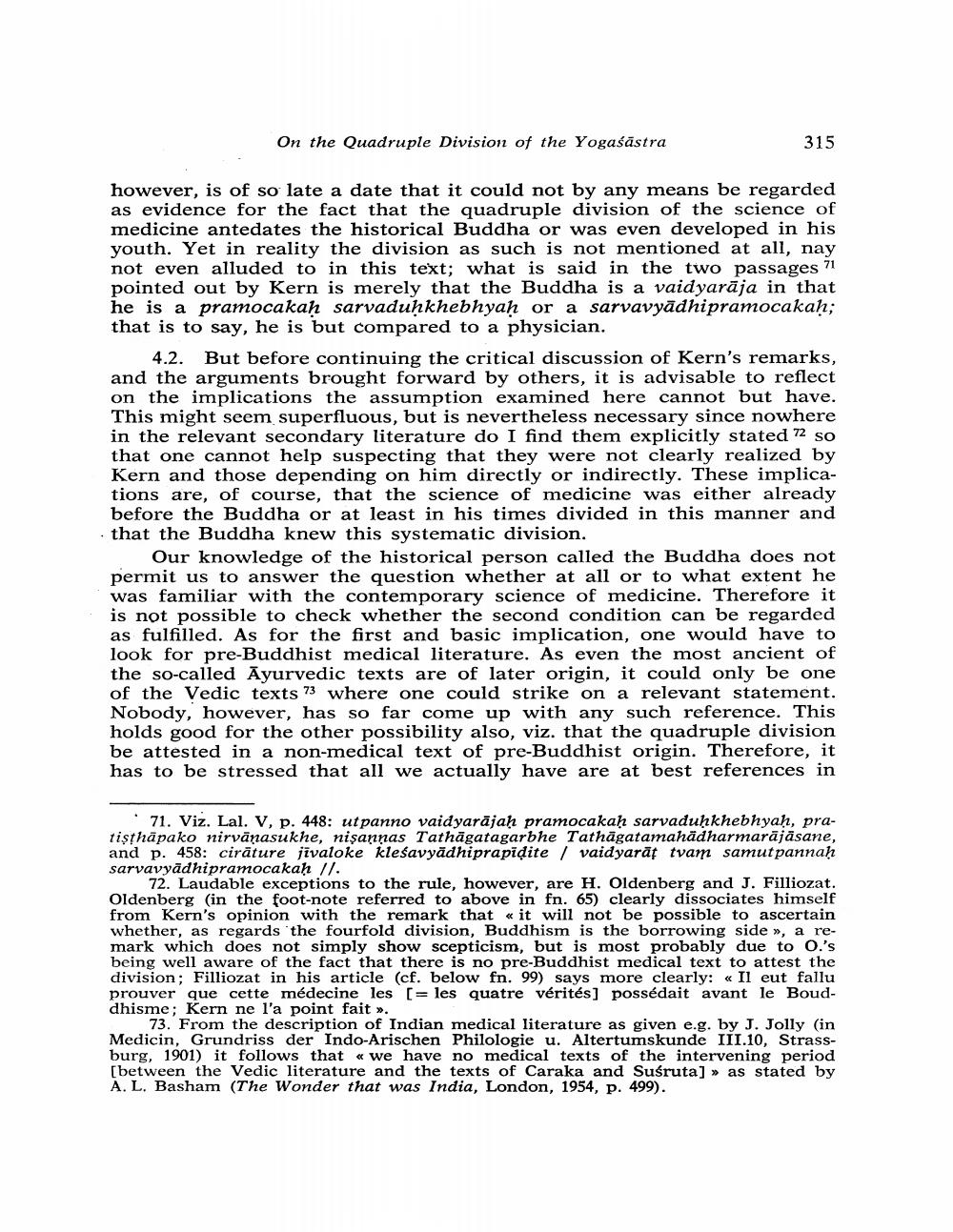________________
On the Quadruple Division of the Yogaśāstra
315
however, is of so late a date that it could not by any means be regarded as evidence for the fact that the quadruple division of the science of medicine antedates the historical Buddha or was even developed in his youth. Yet in reality the division as such is not mentioned at all, nay not even alluded to in this text; what is said in the two passages 71 pointed out by Kern is merely that the Buddha is avaidyarāja in that he is a pramocakaḥ sarvaduḥkhebhyah or a sarvavyādhipramocakah; that is to say, he is but compared to a physician.
4.2. But before continuing the critical discussion of Kern's remarks, and the arguments brought forward by others, it is advisable to reflect on the implications the assumption examined here cannot but have. This might seem superfluous, but is nevertheless necessary since nowhere in the relevant secondary literature do I find them explicitly stated 72 so that one cannot help suspecting that they were not clearly realized by Kern and those depending on him directly or indirectly. These implications are, of course, that the science of medicine was either already before the Buddha or at least in his times divided in this manner and that the Buddha knew this systematic division.
Our knowledge of the historical person called the Buddha does not permit us to answer the question whether at all or to what extent he was familiar with the contemporary science of medicine. Therefore it is not possible to check whether the second condition can be regarded as fulfilled. As for the first and basic implication, one would have to look for pre-Buddhist medical literature. As even the most ancient of the so-called Ayurvedic texts are of later origin, it could only be one of the Vedic texts 73 where one could strike on a relevant statement. Nobody, however, has so far come up with any such reference. This holds good for the other possibility also, viz. that the quadruple division be attested in a non-medical text of pre-Buddhist origin. Therefore, it has to be stressed that all we actually have are at best references in
71. Viz. Lal. V, p. 448: ut panno vaidyarājah pramocakah sarvadunkhebhyah, pratişthāpako nirvänasukhe, nişannas Tathāgatagarbhe Tathāgatamahädharmarājāsane, and p. 458: cirāture jivaloke klesavyādhiprapidite / vaidyarāt tvam samutpannah sarvavyādhipramocakah 17.
72. Laudable exceptions to the rule, however, are H. Oldenberg and J. Filliozat. Oldenberg (in the foot-note referred to above in fn. 65) clearly dissociates himself from Kern's opinion with the remark that « it will not be possible to ascertain whether, as regards the fourfold division, Buddhism is the borrowing side », a remark which does not simply show scepticism, but is most probably due to 0.'s being well aware of the fact that there is no pre-Buddhist medical text to attest the division; Filliozat in his article (cf. below fn. 99) says more clearly: « Il eut fallu prouver que cette médecine les [= les quatre vérités] possédait avant le Bouddhisme; Kern ne l'a point fait ».
73. From the description of Indian medical literature as given e.g. by J. Jolly (in Medicin, Grundriss der Indo-Arischen Philologie u. Altertumskunde III.10, Strassburg, 1901) it follows that « we have no medical texts of the intervening period [between the Vedic literature and the texts of Caraka and Suśruta] » as stated by A. L. Basham (The Wonder that was India, London, 1954, p. 499).




